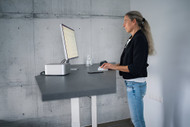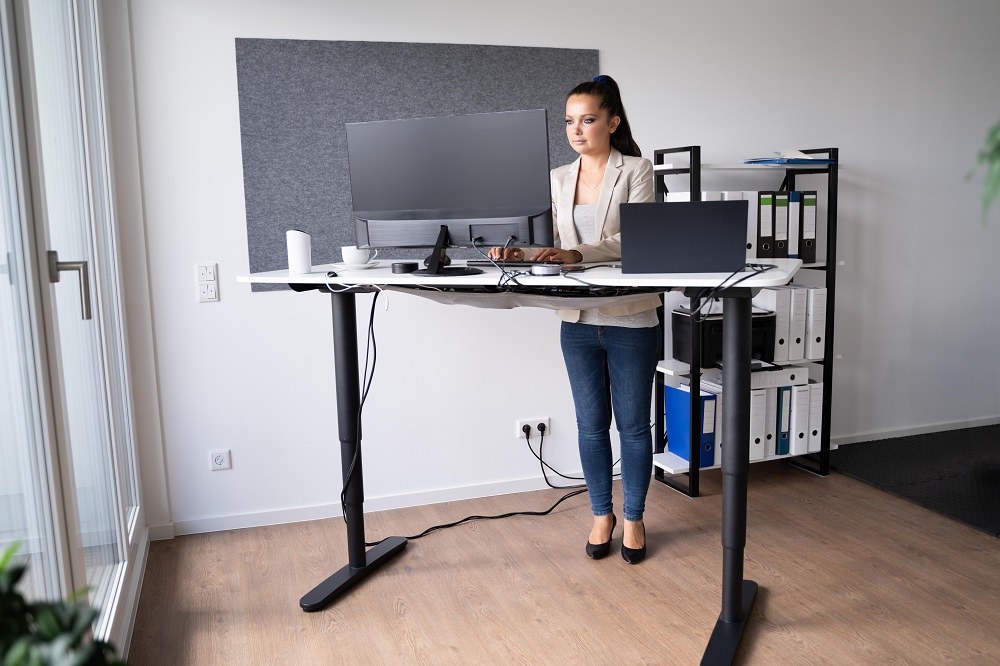Choosing the right height-adjustable desk for your workspace is a pivotal decision that can significantly impact your comfort, health, and productivity. As the popularity of standing desks continues to grow, so does the variety of available options.
These desks offer the flexibility to switch between sitting and standing throughout the workday, promoting better posture and reducing the risks associated with prolonged sitting.
However, the abundance of choices—from materials and ergonomic features to budget considerations—can make the selection process daunting.
It's essential to prioritize factors such as durability, ergonomic design, ease of installation, budget constraints, and aesthetic appeal.
By understanding your specific needs and evaluating these criteria thoughtfully, you can ensure that the desk you choose fits seamlessly into your workspace and supports a healthy and productive work environment.
Standing Desks Should Be Height-Adjustable. Why?
While standing desks have gained widespread recognition for their potential health benefits, the advantages can be significantly compromised if the desk is fixed in height rather than adjustable. Here’s why the adjustability of a standing desk is crucial:
1. Accommodates Different Users: Workspaces are often shared among individuals of varying heights. A fixed-height desk cannot effectively cater to everyone's ergonomic needs.
This allows users to customize the desk to their optimal sitting and standing positions, promoting proper posture and reducing the risk of strain or discomfort.
2. Promotes Movement Throughout the Day: The ability to switch between sitting and standing positions effortlessly encourages regular movement. This dynamic posture variation helps combat the physical and mental fatigue that can arise from prolonged static positions.
Movement throughout the day also improves circulation, delivering more oxygen and nutrients to muscles and enhancing overall alertness.
3. Reduces Back Pain and Discomfort: Sitting for extended periods can lead to muscular imbalances and increased pressure on the spine, which can contribute to back pain.
Alternating between sitting and standing throughout the workday helps distribute body weight more evenly, reducing strain on the lower back and core muscles.
This proactive posture management approach can alleviate discomfort and prevent future musculoskeletal issues.
4. Improved Focus and Energy: Studies have shown that standing desks can boost focus, concentration, and energy levels. By reducing the sedentary nature of office work, adjustable standing desks promote better blood flow and oxygenation to the brain, enhancing cognitive function and productivity.
Factors to Consider Choosing a Height-Adjustable Desk

With a clear understanding of the benefits, let's delve into the key factors to consider when selecting your height-adjustable desk:
1. Adjustment Options:
- Height Range: Ensure the desk adjusts to accommodate your sitting and standing heights. Also, find out how high a standing desk should be.
Ideally, the lowest point should allow your elbows to rest comfortably at a 90-degree angle while seated, and the highest point should allow for a slight bend at the elbows while standing. - Adjustment Mechanism: Desks offer electric or manual adjustment mechanisms.
Electric motors provide smooth, effortless height changes, while manual cranks may require more effort but can be a more budget-friendly option.
2. Durability:
An adjustable-height desk represents a significant investment, so selecting one built to withstand daily use over the long term is crucial.
Look for desks constructed from robust materials such as high-grade steel for the frame and a durable laminate or hardwood for the desktop. These materials ensure stability and resist wear and tear, maintaining the desk's structural integrity.
Additionally, consider the desk's weight capacity to ensure it can comfortably support your computer equipment and monitor setup without strain or risk of instability.
3. Ergonomics:
Beyond mere adjustability, prioritize the to promote optimal comfort and health. The desk should provide ample legroom and a spacious surface area that accommodates your monitor, keyboard, mouse, and other essentials.
Look for features such as a curved or contoured desktop that conforms to natural body movements and supports proper arm positioning while typing or using a mouse.
A built-in keyboard tray or adjustable keyboard platform can further enhance ergonomics by allowing you to maintain a neutral wrist position, reducing the risk of strain or injury during prolonged use.
4. Ease of Installation:
When selecting a height-adjustable desk, consider the ease of assembly and installation. Some desks come pre-assembled or partially assembled, requiring minimal effort to set up, while others may involve more extensive DIY assembly.
Opt for a desk that includes clear, user-friendly instructions, and consider the availability of customer support or resources for assistance if needed.
Prioritizing ease of installation ensures a smoother transition to using your new desk without unnecessary frustration or delays.
5. Budget:
These desks are available across a wide range of price points, so it's essential to establish a budget based on your specific needs and preferences. Consider the features and quality that align with your budgetary constraints while prioritizing durability and ergonomic functionality.
Investing in a well-designed desk tailored to your work habits and health requirements can potentially save you from future medical expenses associated with poor ergonomics or discomfort.
6. Aesthetics:
The visual appeal of your desk plays a significant role in creating a conducive and inspiring workspace. Choose a design that harmonizes with your existing office decor and personal style preferences.
Consider factors such as the desk's size, color options, and material finish to ensure it enhances the overall ambience of your workspace.
Aesthetics contribute to a positive work environment, fostering motivation and productivity throughout your workday.
Benefits of Choosing the Right Height-Adjustable Desk

Investing in the right height-adjustable desk can bring a multitude of benefits to your work life:
- Improved Posture and Reduced Back Pain: By alternating between sitting and standing, you can reduce strain on your back and core muscles, leading to better posture and potentially reducing back pain
- Improved Blood Flow and Circulation: Alternating between sitting and standing positions throughout the day encourages movement, which helps improve blood flow and circulation. This can lead to increased energy levels and a reduction in fatigue.
- Boosted Mood and Reduced Stress: Standing desks can positively impact mood and reduce stress levels. Moving throughout the day and avoiding prolonged sitting can contribute to a more positive and productive work environment.
- Weight Management: While not a standalone solution, height-adjustable desks can help with weight management by promoting movement and potentially burning more calories than sitting for extended periods.
How to Make the Most of Your Adjustable-height Desk
Once you've invested in the perfect height-adjustable desk, here are some tips to maximize its benefits:
- Set Up Your Workstation Ergonomically: Ensure your monitor is at eye level, your keyboard and mouse are positioned for comfortable arm placement, and you have ample legroom while standing.
Utilize an ergonomic chair for the times you choose to sit. Consider an anti-fatigue mat for added comfort while standing for extended periods. - Alternate Between Sitting and Standing: Aim to stand for short periods throughout the day.
Start by incorporating standing intervals of 15-20 minutes and gradually increase the duration as you get accustomed to it. Listen to your body and take breaks as needed. - Invest in a Comfortable Anti-Fatigue Mat: Standing on a hard surface for extended periods can cause discomfort.
An anti-fatigue mat provides a cushioned surface that promotes better circulation and reduces strain on your legs and feet. - Stay Hydrated: Standing for longer durations can make you more easily dehydrated. Drink plenty of water throughout the day to stay hydrated and energized.
- Incorporate Movement Throughout Your Day: Even with an adjustable height desk, it's important to get up and move around regularly. Take short walks, stretch, or do some light exercises to keep your blood flowing and prevent stiffness.
Is it Time to Upgrade Your Workspace?
An adjustable-height desk could be a game-changer if you spend long hours at your desk and experience discomfort, fatigue, or back pain. Consider the following:
- Do you experience back pain, neck pain, or shoulder tension?
- Do you feel sluggish or tired throughout the workday?
- Do you find yourself fidgeting or constantly shifting positions while sitting?
- Would you like to create a more dynamic and healthy work environment?
If you answered yes to any of these questions, then investing in a height-adjustable desk might be the perfect solution to boost your comfort, well-being, and, ultimately, your productivity.
Bottom Line
Selecting the right adjustable desk for your workspace involves careful consideration of durability, ergonomics, ease of installation, budget, and aesthetics. A desk that combines robust construction with ergonomic features tailored to your needs can significantly enhance both comfort and productivity.
Whether you prioritize durability for long-term use, ergonomic design for optimal health benefits, or a stylish appearance to complement your office environment, investing in the right desk is crucial.
Organizations looking to furnish their offices with premium standing desks in bulk can turn to ONERGON for solutions that meet high-quality standards, ensuring employees have ergonomic workstations that support their well-being and enhance workplace efficiency.
Visit our website today.




